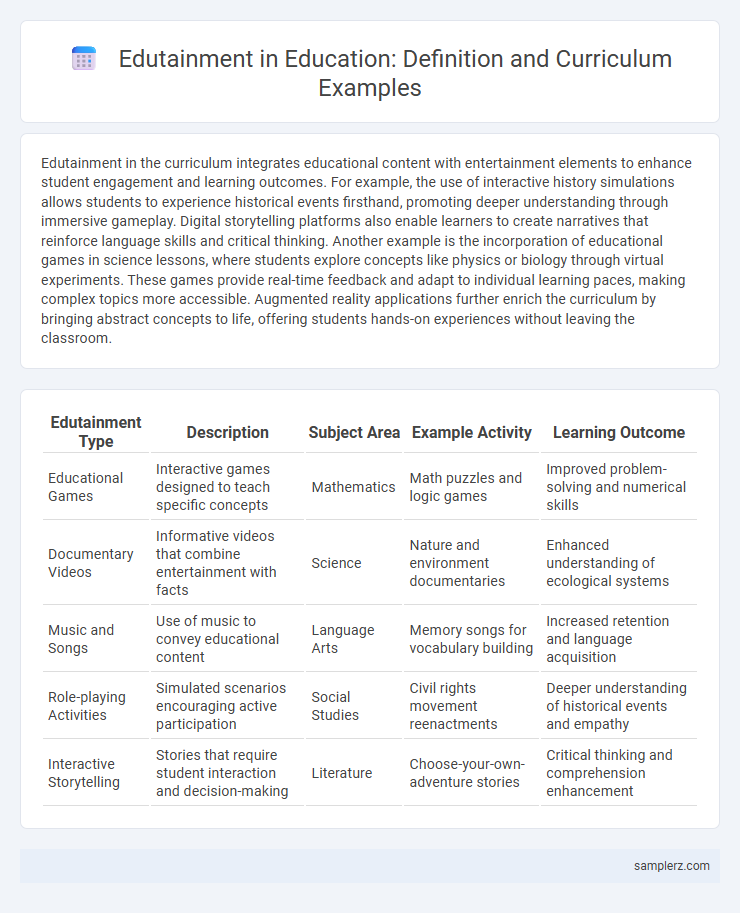Edutainment in the curriculum integrates educational content with entertainment elements to enhance student engagement and learning outcomes. For example, the use of interactive history simulations allows students to experience historical events firsthand, promoting deeper understanding through immersive gameplay. Digital storytelling platforms also enable learners to create narratives that reinforce language skills and critical thinking. Another example is the incorporation of educational games in science lessons, where students explore concepts like physics or biology through virtual experiments. These games provide real-time feedback and adapt to individual learning paces, making complex topics more accessible. Augmented reality applications further enrich the curriculum by bringing abstract concepts to life, offering students hands-on experiences without leaving the classroom.
Table of Comparison
| Edutainment Type | Description | Subject Area | Example Activity | Learning Outcome |
|---|---|---|---|---|
| Educational Games | Interactive games designed to teach specific concepts | Mathematics | Math puzzles and logic games | Improved problem-solving and numerical skills |
| Documentary Videos | Informative videos that combine entertainment with facts | Science | Nature and environment documentaries | Enhanced understanding of ecological systems |
| Music and Songs | Use of music to convey educational content | Language Arts | Memory songs for vocabulary building | Increased retention and language acquisition |
| Role-playing Activities | Simulated scenarios encouraging active participation | Social Studies | Civil rights movement reenactments | Deeper understanding of historical events and empathy |
| Interactive Storytelling | Stories that require student interaction and decision-making | Literature | Choose-your-own-adventure stories | Critical thinking and comprehension enhancement |
Integrating Gamification in Classroom Lessons
Integrating gamification in classroom lessons enhances student engagement by applying game design elements such as point scoring, leaderboards, and interactive challenges to educational content. This approach improves knowledge retention and motivation by creating immersive learning experiences that encourage active participation and collaboration among students. Schools implementing gamified curricula report increased student achievement and positive attitudes towards subjects like mathematics and science.
Utilizing Educational TV Shows as Learning Tools
Educational TV shows like "Sesame Street" and "Bill Nye the Science Guy" effectively blend entertainment with curriculum concepts to enhance student engagement and understanding. Incorporating these programs into lesson plans supports diverse learning styles by providing visual and auditory stimuli that reinforce language, science, and social skills. Studies show that students exposed to educational television exhibit improved retention and motivation, making these shows valuable tools for interactive and media-rich learning environments.
Interactive Storytelling for Enhanced Comprehension
Interactive storytelling in the curriculum leverages multimedia tools and gamified narratives to boost student comprehension and engagement. Through role-playing scenarios and branching storylines, learners actively participate in knowledge construction, enhancing retention and critical thinking skills. This edutainment approach aligns with cognitive theories that emphasize active involvement for deeper understanding.
Incorporating Virtual Reality in Science Education
Incorporating virtual reality (VR) in science education enhances student engagement by providing immersive, interactive simulations of complex scientific concepts such as molecular structures and planetary systems. VR tools enable experiential learning, allowing students to visualize and manipulate 3D models, which improves comprehension and retention. This edutainment approach fosters deeper understanding by blending entertainment with educational content, making science both accessible and captivating.
Music-Based Learning Activities for Young Students
Music-based learning activities in early childhood education enhance cognitive development and language skills by integrating rhythm, melody, and movement. Utilizing songs and interactive instruments, educators create engaging environments that support memory retention and social interaction among young learners. Studies show that children exposed to music-based curricula exhibit improved auditory discrimination and heightened creativity, making edutainment an effective tool in foundational education.
Leveraging Educational Mobile Apps in Curriculum
Leveraging educational mobile apps in the curriculum enhances student engagement through interactive learning experiences and personalized feedback. Apps like Kahoot!, Duolingo, and Khan Academy integrate gamified content and adaptive exercises that support diverse learning styles and facilitate real-time assessment. Incorporating these tools into lesson plans promotes deeper understanding and improves knowledge retention by combining education with entertainment.
Role-Playing Games to Teach Social Skills
Role-playing games (RPGs) integrated into educational curricula serve as effective tools to enhance students' social skills by simulating real-life social interactions and decision-making scenarios. These games encourage collaboration, empathy, and conflict resolution, providing experiential learning opportunities that traditional teaching methods often lack. Research shows that students engaged in RPG-based learning demonstrate improved communication skills and greater emotional intelligence, essential competencies in modern education.
Project-Based Learning through Digital Media
Project-Based Learning through Digital Media engages students by integrating technology with collaborative problem-solving tasks, enhancing creativity and critical thinking. Platforms like virtual simulations, video production, and interactive storytelling enable immersive experiences that align with curriculum objectives. This edutainment approach increases motivation and retention by making education both enjoyable and relevant.
Using Animation Videos for Complex Concepts
Animation videos enhance student comprehension by visually representing complex concepts such as molecular biology or physics principles, making abstract ideas more tangible. Incorporating these videos into the curriculum fosters engagement and improves retention by combining entertainment with education. Studies show that learners exposed to animated content demonstrate higher test scores and greater enthusiasm for challenging subjects.
Art and Drama Workshops to Foster Creativity
Art and Drama Workshops integrated into educational curricula enhance student creativity by providing immersive, hands-on experiences that stimulate imagination and self-expression. These workshops encourage collaborative problem-solving and emotional intelligence development through role-playing and creative arts projects. Research shows that students engaging in such edutainment activities demonstrate improved critical thinking, communication skills, and increased motivation towards learning.

example of edutainment in curriculum Infographic
 samplerz.com
samplerz.com